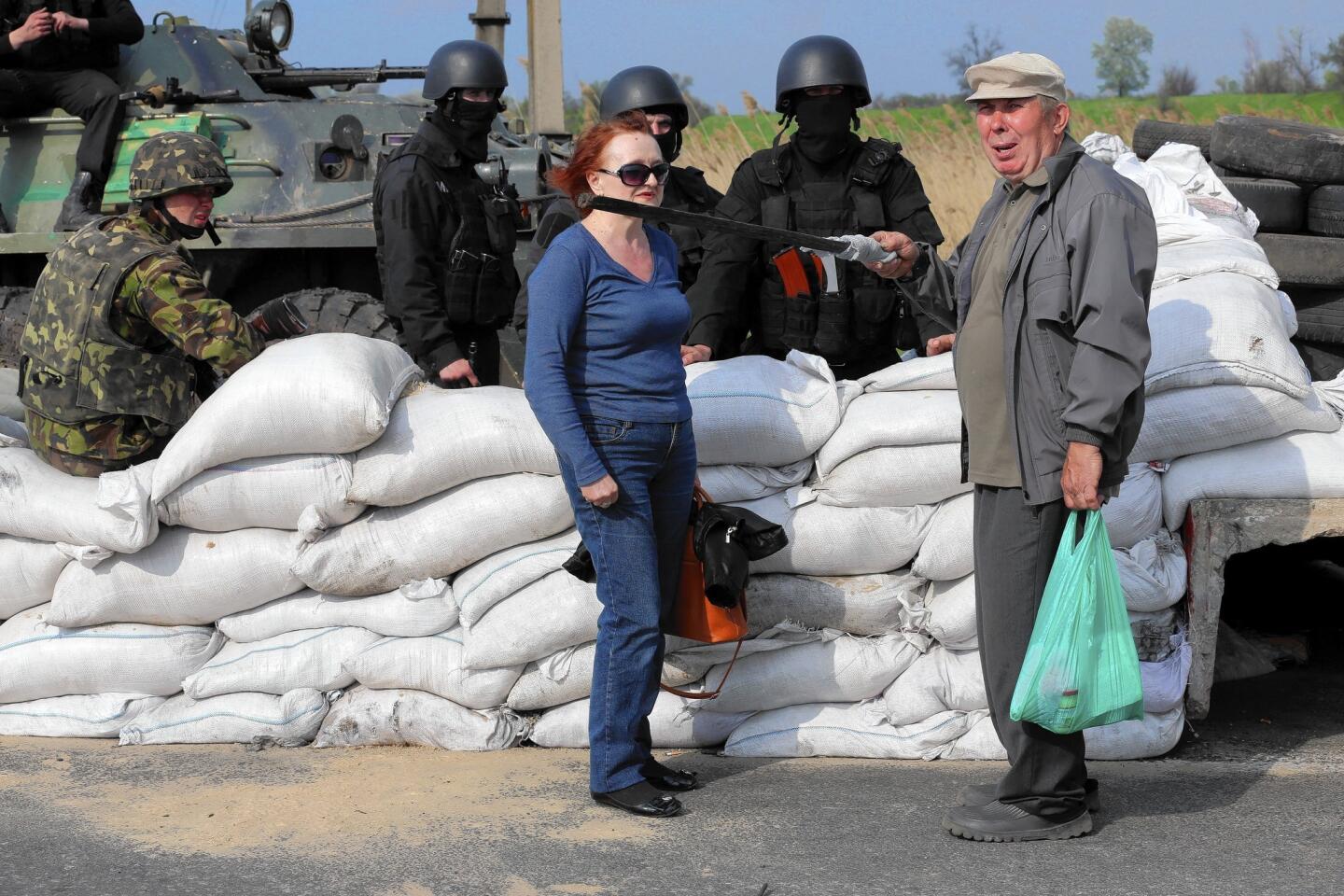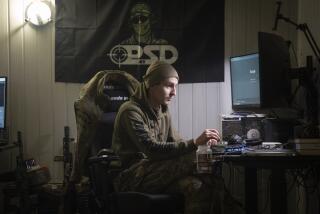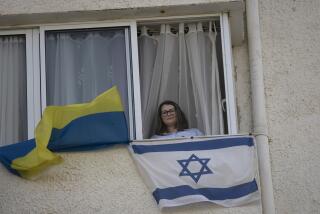Residents of eastern Ukraine cities struggle to go on with life
The farmer slowly walked up the hill toward her barn, with her driver following behind in the minivan. She waved her arms to be seen by the Ukrainian paratroops guarding a nearby television tower. She knew her vehicle might look suspicious and hoped her desperate signals would convince the soldiers she meant no harm.
The paratroops had taken back control of the tower from gunmen two days before. It was a small skirmish in a conflict that has turned this town — and much of eastern Ukraine — into a battleground between pro-Russia separatists and the nation’s struggling interim government.
Caught between the factions, farmer Inna Zakharova — like so many Ukrainians in the east — is struggling to go on with life amid the chaos and violence.
“My season plans go down the drain with this war,” Zakharova, 35, said Sunday. “I have 20 hectares of local land to plant onions, potatoes, cabbages and carrots, but my seasonal workers are afraid to come to Slovyansk now.”
Zakharova’s farm has been a success since she began it in the late 1990s, given the fertile black soil of eastern Ukraine. But now, as the separatists in Slovyansk are surrounded by Ukrainian security forces, her whole enterprise is at risk of collapse.
“I am not involved in politics, I am an ordinary woman and an ordinary farmer,” Zakharova said. “Why do they have to turn this land into a battlefield?”
Vitaly Kolesnik, the supply chief for the Slovyansk electrical district, asked himself a similar question as he drove back down the hill at full speed after the soldiers threatened to shoot him if he came any farther.
Kolesnik wanted to see what was wrong with the power line near the television tower that appeared to have been damaged during the fighting two days earlier, cutting off power supplies to at least three suburbs.
“When I approached their position, they pointed a large-caliber machine gun at me and told me to get the hell out of there,” Kolesnik said, breathing heavily from stress and frustration. “I explained to them my mission and the plight of the residents sitting without electricity in such hot weather, but they wouldn’t listen!”
“I am giving up on that one,” Kolesnik said, wiping sweat from his balding head before driving away. “I do care about the local people, but I am not ready to risk my life for their want of comfort.”
Sunday brought a relative lull to the fighting in Slovyansk, though not to cities elsewhere in eastern Ukraine. A crowd of more than 2,000 pro-Russia separatists seized the military prosecutor’s office in Donetsk, one of the last key official sites in the city still in the hands of the country’s interim government.
In Odessa, where a violent clash triggered a fire that left 43 people dead Friday, a district police station was surrounded Sunday by several hundred separatists demanding the release of protesters detained during the earlier fighting. In the end, police released 67 people.
Pro-Russia armed gunmen who Ukrainian authorities say were led by Russian mercenaries seized Slovyansk on April 12 and took the television tower a week ago, switching off Ukrainian TV channels and turning on Russian ones instead.
Ukrainian troops wrested the tower back in a gunfight, restoring Ukrainian broadcasts — the propaganda war fought amid real gunfire.
For residents of Andreyevka, a Slovyansk suburb, who controls the tower is a bit of a moot point: With no electricity, they can’t watch either Russian or Ukrainian television.
A woman who would give only a partial name of Vera Stepanovna for safety’s sake spent Sunday in a dark, stuffy food shop with shelves half-empty. On Saturday, after the latest round of shooting in Slovyansk was over, she said, people ran to her shop to buy enough food to last a month.
“For a week now the supply truck has not been coming,” she said. “There’s no electricity and I am running out of my stocks and customers. I’d better pick up the cat and go home.”
She patted a gray cat sitting on a shelf below a half-empty counter and started to pack up.
Dozens of downed poplar trees, along with piles of auto tires and ancient trucks, block the narrow streets of Slovyansk. The few cars trying to make their way through town take to the sidewalks or what’s left of the lawns.
A minibus with a Russian flag carrying masked men with Kalashnikovs and grenade launchers was zigzagging around one barricade as factory worker Yuri Zakharov, 50, spat on the ground and cursed.
“These guys in masks came from nowhere and turned our lives into hell,” he said. “I didn’t like [acting Prime Minister Arseny] Yatsenyuk before but would prefer him any day over these bandits.”
Fighting in Slovyansk had killed more than a dozen people and injured scores more in recent days. With Sunday’s lull, a few people appeared in the streets, looking to see which shops were open. Some residents strolled with their children. Some fed pigeons on the main square, which bore the tread marks of armored vehicles.
But outside Slovyansk, troops from the Ukrainian Interior Ministry, army and national guard were tightening a noose around the town, manning checkpoints on every road going in and out of the city, searching vehicles and demanding to see the papers of every driver and passenger.
One soldier showed a collection of seized baseball bats — in a land where most people have no knowledge of the game. “We confiscated a sizable number of firearms too,” he said proudly.
The blockade will continue to prevent the rebels from sneaking out of Slovyansk or getting reinforcements and weapons supplies, an Interior Ministry troops unit commander said.
“We are dealing not with an army but with a relatively small number of professional Russian warriors down there,” said the officer, who gave his name only as Sergei. “We know all their code names from intercepted radio and telephone communications and we are hunting them in a targeted way. They are already 10 men down. Two days ago we took out their most dangerous Russian Cossack sniper code-named Romashka [chamomile]. None of them will get out alive.
“I understand the residents may experience some discomfort now, but they will be the first to thank us in the end when we are done with these thugs and criminals,” he said.
More to Read
Start your day right
Sign up for Essential California for news, features and recommendations from the L.A. Times and beyond in your inbox six days a week.
You may occasionally receive promotional content from the Los Angeles Times.







